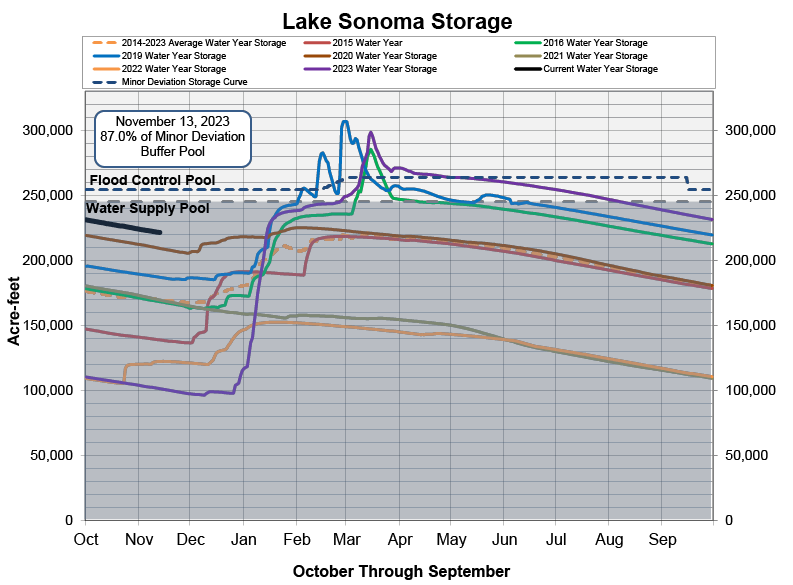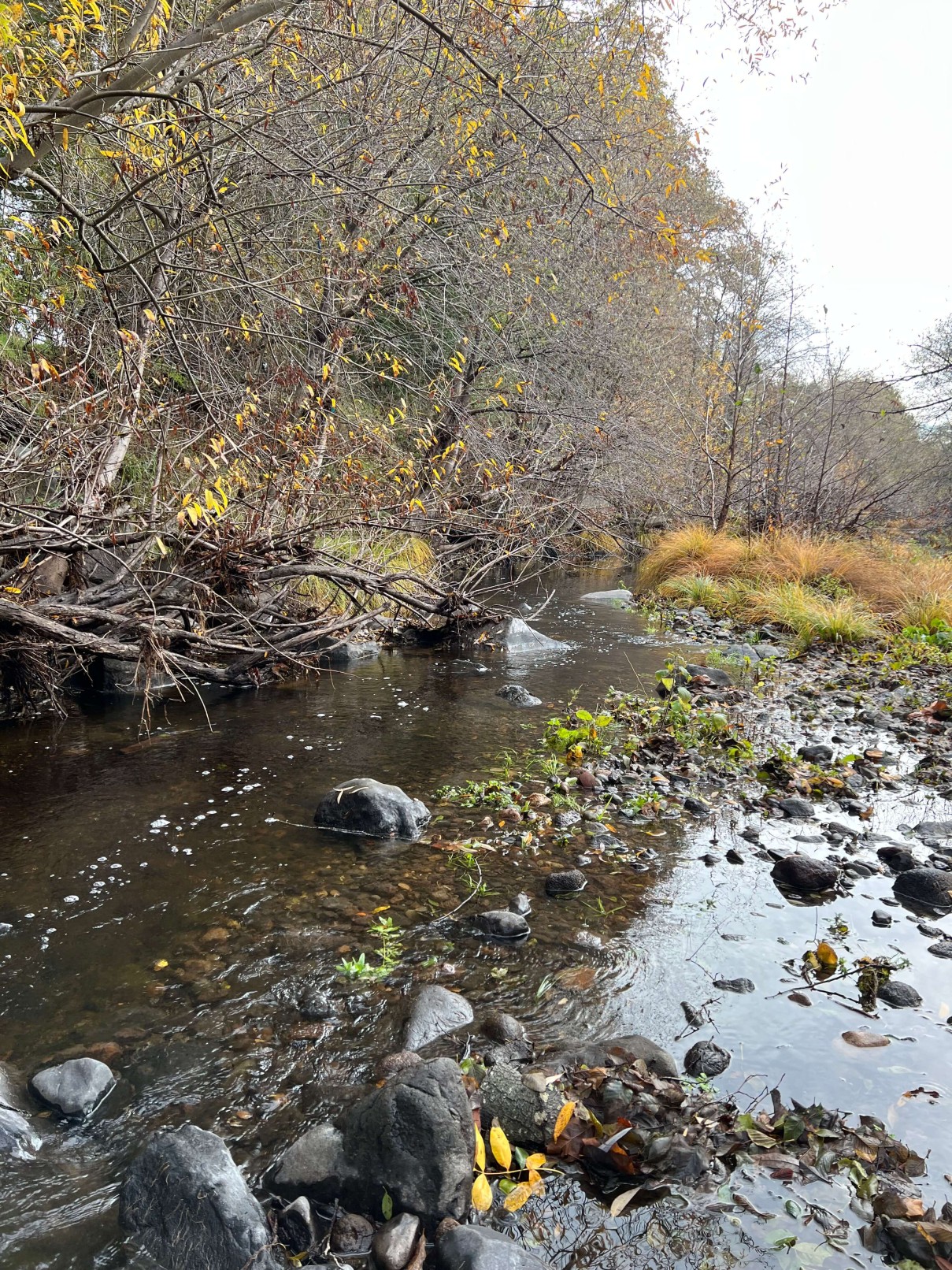It’s been an incredible year for water in California. The influx of rain has eased the prolonged megadrought. Yet, our state of water is more complex than abating the drought. As we head into another wet season this year, we spoke to Sonoma Ecology Center’s Senior Scientist and Research Program Manager, Steven Lee, to get a better understanding of what we are hopeful about, and what challenges remain in the state of water in Sonoma Valley and California at large.

A diagram of Sonoma Water’s supply network. Photo courtesy of Valley of the Moon Water District.
Can you tell us where Sonoma Valley gets most of its water from?
Water in Sonoma Valley comes from a combination of private wells and surface water impoundments on more rural properties around the fringe of the valley floor along with domestic supply delivered by the Valley of the Moon Water District, mostly to the more densely developed areas of the valley floor. Valley of the Moon Water District’s supply primarily consists of purchased water from Sonoma Water, delivered via an aqueduct from Santa Rosa, but also includes a combination of high volume wells here in the valley. Sonoma County’s primary water source is Lake Sonoma, and to a lesser degree the interconnected reservoirs of Lake Mendocino and Lake Pillsbury. Sonoma County does not receive any of its supply from the Sierra snowpack. The quality and quantity of snow in the Sierra is critical to the statewide water picture, but not Sonoma County.
This year has been referred to as a miracle water year for California by some news outlets. What does this mean for Sonoma Valley?
I have not heard it referred to as a miracle water year, but it was a very good year for water. It all depends on the timing and amplitude of the rain. Take the prior 2021/2022 water year: by the Spring of 2022, we reached our average precipitation level (~30” in Sonoma) and yet the water level in Lake Sonoma remained critically low. Comparing that to the 2022/2023 “miracle” water year we just had, by the time we reached that same amount of precipitation in Winter 2023, the lake was essentially full. Going back to the previous water year, the huge volume of rain we had rain in October 2021 (same amount in 1-2 days as occurred over the entire water year before that) fell on completely dry ground. That still caused flooding and some degree of reservoir filling, but not nearly what would have been seen if that same volume of rain had fallen on already-saturated ground. By the time significant rains fell in 2022-2023, the ground was already saturated by a series of lower intensity events. This allowed for creeks to swell and for Lake Sonoma to rapidly fill back up. The current water level in Lake Sonoma is in a better place at the end of the dry season than it has been in years. But the timing of precipitation this past year also allowed for greater infiltration into the groundwater which bolstered our local water supply and provided better perennial flow in the creeks all summer long.
With respect to groundwater and dry season streamflow in the creeks, what we want to see is saturated ground and long duration, low intensity rain events arriving thereafter.

Water levels over time at Lake Sonoma, Sonoma County’s primary water source. Source: Sonoma Water.
As you can see on the black trend line on the graph above that we are starting out the year in a very good place with respect to the county water supply. We are expecting a warm, wet El Nino winter.

Sonoma Creek in the winter. Intense rain in short time periods during the wet months can cause the creek’s banks to erode and steepen. These events can also lower the bottom of the creek, which can reduce our groundwater supply.
What do you see as some challenges that California will continue to face or consider in regards to our water system, if any?
The climate is changing. While we are not seeing less overall rain (meaning a notable departure from our average annual precipitation level through the wet and dry cycles), the rain is increasingly arriving in shorter duration, high intensity events. This is causing most of the water to rush straight down the creeks and into the bay instead of having time on the landscape to sink in and become groundwater. When I was a kid growing up here in the Valley, there were way more extended periods of wet, drizzly days during the winter. The creeks had much more water in the summertime, which provided healthier habitat for fish and other creek species as well as wonderful swimming holes. Now, torrents of water rushing down the creek in the winter cause the banks to erode and steepen. They also scour and lower the streambed (bottom of the stream), thus further draining the shallow aquifer on the valley floor, which reduces our groundwater supply.
Sonoma Ecology Center partners with Master Gardeners of Sonoma County to showcase different rain capture techniques at Sonoma Garden Park. Rain capture demonstrations such as the ones at Sonoma Garden Park allows stormwater to slow and sink into the ground, which replenishes our groundwater and prevents polluting runoff.
What are some of the best ways that California residents or cities can make the most out of our wet years?
Given the above, we have to find a way to retain water on the landscape during those short duration, high intensity events when most of the Valley’s precipitation is being lost to the ocean and degrading the creeks in the process. This means finding ways to prevent the concentration of water flowing to the creeks through pipes and roadside ditches and instead get that water to remain spread out on the landscape and/or be directed into retention zones like swales, depressions and impoundments. Physically diverting the water during high flow periods from creeks into streamside retention ponds or other storage and infiltration zones is another option. Replacing impervious surfaces such as roofs, concrete and blacktop areas with other materials or strategies that allow for percolation (water sinking into the ground) can be done where logistically practical. Intentionally taking advantage of these areas as catchment zones for rainwater harvesting is another excellent choice, such as the 70,000 gallon rainwater harvesting project I installed at my own home and the 20,000 gallon system SEC installed at Flowery Elementary School.
